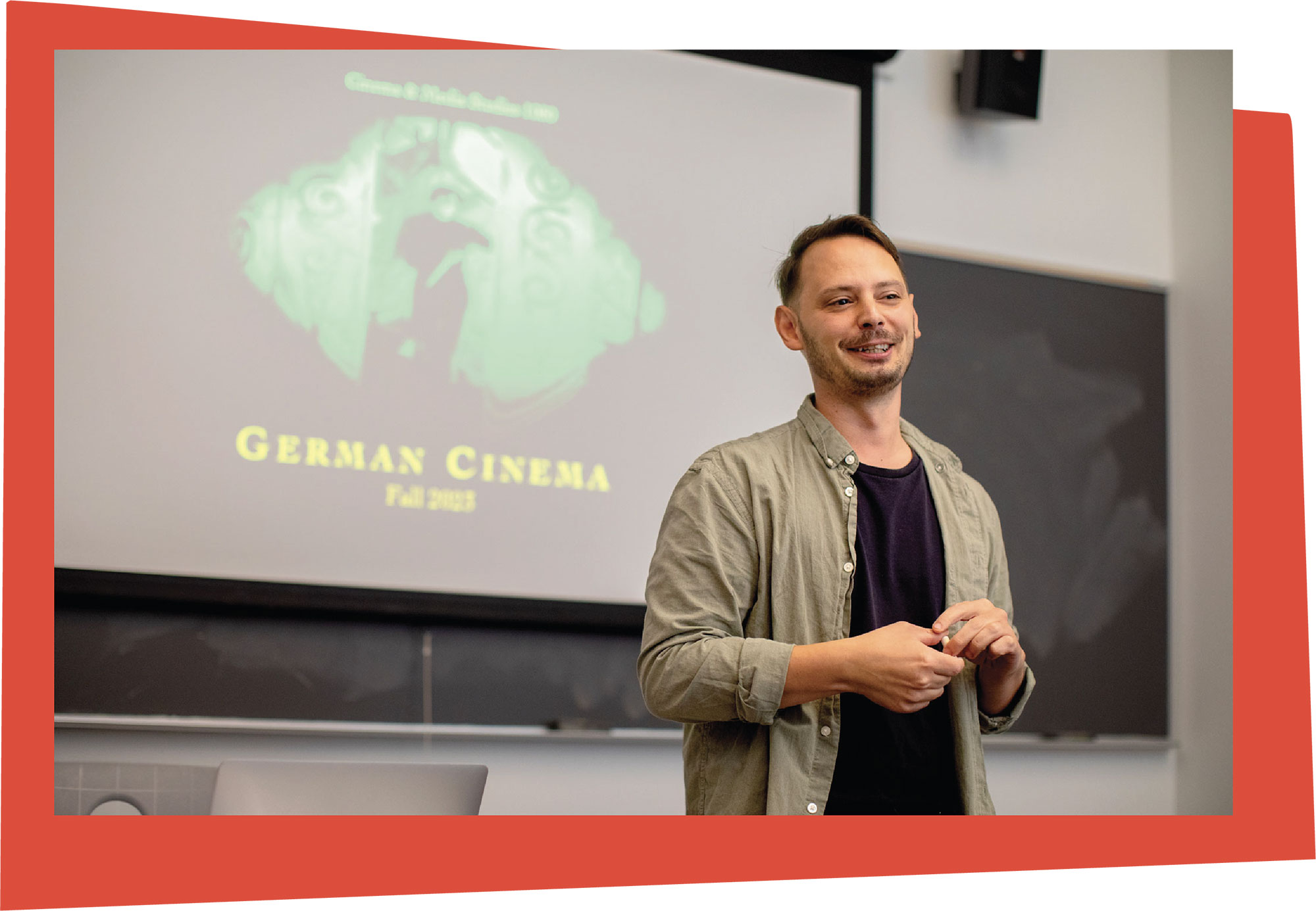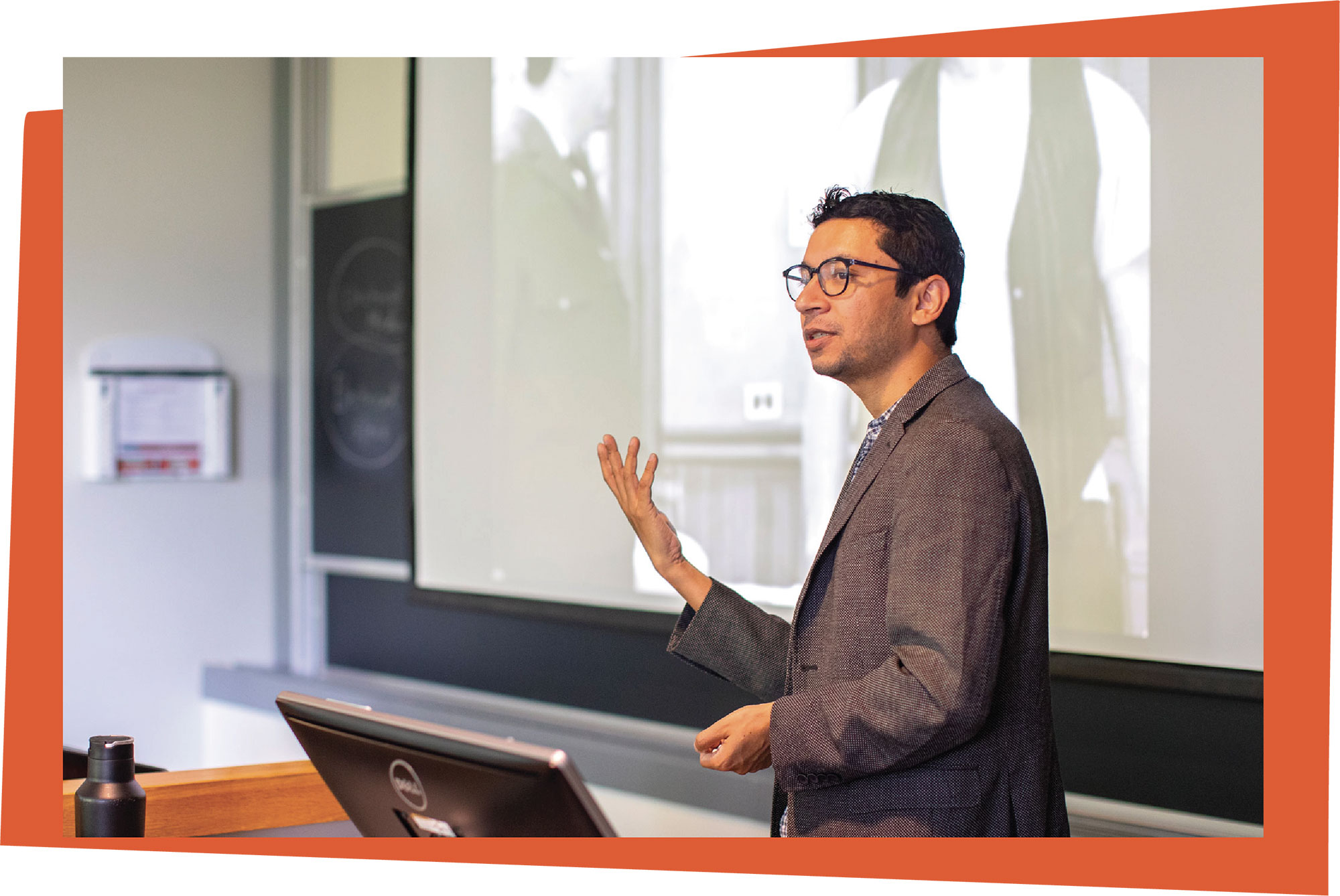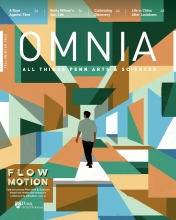Viewing an exclusive movie premiere at the world-famous Cannes Film Festival. Studying documentary filmmaking in Kenya. Interning at a top Los Angeles movie studio. For two decades, students in Penn’s Cinema & Media Studies (CIMS) program have had access to such experiences, and this year, the program takes a big leap forward, becoming Penn Arts & Sciences’ newest academic department.
Why the change? “One of the major catalysts to form a department revolved around Ph.D. students,” says Karen Redrobe, Elliot and Roslyn Jaffe Professor of Cinema & Media Studies. Redrobe served as program director this past year and oversaw the process of transitioning CIMS to department status. She explains that prior to the change, graduate students interested in cinema and media studies needed to enroll in other departments such as English, history of art, or anthropology to pursue an Arts & Sciences doctoral degree.
“It was hard to feel a sense of community when grad students were based in different departments,” she says. “They had to fulfill the requirements of their various disciplines while developing their training in cinema & media studies at the same time. It was almost like doing two Ph.D. programs, especially at the coursework level.”
Equally important, becoming a department makes it possible to hire dedicated CIMS faculty. As with graduate students, professors teaching in the CIMS program have been hired through other departments—including Redrobe, whose position previously fell under history of art.
Ian Fleishman, Chair and Associate Professor of Cinema & Media Studies, agrees. “We’re proud to have drawn on our colleagues in the humanities across the University, but with this change we’ll gain more independence in how we set our own hiring priorities.”

Students watch a film during Professor Rahul Mukherjee's Television and New Media class.
Built From Scratch
Film studies gained traction as an academic discipline in the 1960s. Timothy Corrigan, Emeritus Professor of English, Cinema & Media Studies, and History of Art, joined Penn in 2003 as founding director of what was then called the Cinema Studies Program, which initially offered only an undergraduate minor.
During Corrigan’s first year, he advised the search committee in recruiting Redrobe for the Jaffe Chair. Peter Decherney, today Professor of Cinema & Media Studies and Edmund J. and Louise W. Kahn Endowed Term Professor in the Humanities, came on board through the English department. “We fairly quickly got up to speed with three dedicated cinema studies scholars,” Corrigan says. “The challenge for me was that, in order to build the program, we needed to find more people with not only an interest in film but also experience teaching it.”
Corrigan says CIMS’s long-time associate director Nicola Gentili, who joined the staff in 1998, has been instrumental in managing and developing the program. He helped to recruit instructors from across the University and worked with Corrigan to streamline the curriculum and launch the undergraduate major in 2004, which quickly attracted dozens of students. Today CIMS has 37 declared majors and 38 minors.
“A Student-First Enterprise”
Ask Corrigan what the CIMS program’s foundational strength is and he’s quick to answer: providing undergraduates with a discipline they longed to study. “The fact that we got so many majors so quickly is not just because we had a good program,” he says, “but because young people really respond to film, they respond to media.”
CIMS undergraduates have also benefited from hands-on experiences, like an impressive roster of available internships all over the country, facilitated, in part, by ample representation of Penn alums in the film and media industries. And in partnership with Penn Global, Decherney directs the Penn Global Documentary Institute, which brings students to communities across the world to document their stories through various media; students in his Virtual Reality Lab course can learn VR filming techniques. (See “Flow Motion.”)
CIMS began attracting students early on with a graduate certificate and doctoral degrees conferred by collaborative departments. “Through those doors, we’ve had a really phenomenal bunch of grad students over the years who are now well-placed in faculty positions,” says Corrigan.
Redrobe notes that Corrigan, who retired four years ago, “left an imprint as someone who approached this as a student-first enterprise, while also being a very important scholar.” She says the entire CIMS faculty—“all active researchers and creators who also care a lot about teaching and pedagogy”—share those qualities.
The fact that we got so many majors so quickly is not just because we had a good program, but because young people really respond to film, they respond to media.
Fleishman was drawn to cinema & media studies through teaching, specifically a course he led at Harvard, where he struggled to engage the students until he decided to show them a clip of the film M by Fritz Lang. “They came to life,” he says. “And not only did they come to life, but afterwards they were so much better at coming to back to the books and suddenly had more interesting things to say about them. I think there’s something both so familiar about the moving image to students, and so alive about it, that they can come to it at once very critically and very naively.”
An Interdisciplinary Discipline
CIMS currently counts 10 professors as core faculty, covering a broad array of national, historical, and methodological approaches. In addition to Redrobe, Decherney and Rahul Mukherjee have both taken turns as program director. Mukherjee, Dick Wolf Associate Professor of Television and New Media and the department’s new graduate chair, focuses on media more broadly and brings expertise in Indian media. Senior lecturer Meta Mazaj, undergraduate chair, specializes in Balkan cinema and cinemas of Eastern Europe. Assistant Professor Chenshu Zhou’s focus is on East Asia.
Film studies programs and film archives traditionally have prioritized North American and European film and film histories. In expanding the department, Fleishman says he wants to build on the areas covered by current faculty. “We hope, for instance, to make exciting new hires in areas—geographical or otherwise—where we’d like more coverage, including Latin America or African cinema and media traditions.”
Reflecting this expansive view, the word “media” was added to the program title in 2014, acknowledging the broader universe of media in which cinema is only one form.
“Students today are constantly inundated with all manner of media with which they need to engage critically,” says Fleishman. “For this reason, I’m thrilled to have scholars like Rahul working on subjects as diverse as Bollywood thrillers, data management systems, and media coverage of nuclear power plants and cell phone antennas in India.” Fleishman also points to Shannon Mattern, recently hired Penn Presidential Compact Professor of Cinema & Media Studies, who focuses on “media archaeologies,” encompassing everything from stone tablets to urban print cultures to telegraphs and smart cities in the age of big data.
“At a moment of heightened specialization across the academic world,” says Redrobe, “CIMS can function as a hub for the whole University, because you have medical imaging, media systems, storylines, visual art, performance, music, legal questions. There are so many different arenas that moving images play a role in. With cinema and media, we’re also dealing with a very accessible form of visual culture that opens a door to the non-academic world.”
Looking Ahead
This theme of accessibility drives CIMS’s long-time commitment to engaging not only the campus, but also the wider community. “Our public programming rivals almost any department at Penn,” says Fleishman. For example, Wednesday lunch colloquia, featuring top-notch local, national, and international film and media scholars, are open to students and the general public alike. CIMS often partners with student groups and film clubs, and has co-sponsored numerous Philadelphia-based film festivals, most recently the 2023 Black Star Film Festival. Through the University’s partnership with Slought, a cultural and educational nonprofit based in West Philadelphia, CIMS has been co-hosting screenings and other events there on Tuesday evenings.
As the new department prepares to launch full graduate curricula, both for a Ph.D. and a terminal M.A., along with certificates in the discipline, it is also overhauling the undergraduate curriculum.
At a moment of heightened specialization across the academic world, CIMS can function as a hub for the whole University.
“We want to make sure to do this right, so we’re updating our requirements and core courses to better reflect the current state of the field,” Fleishman says. One notable change will come with the introductory three-course sequence: World Film History to 1945, World Film History 1945 to the Present, and Television and New Media. To correct an imbalance between film and media, beginning in the 2023–2024 academic year there will be just two gateway courses: Introduction to Cinema Studies and Introduction to Media Studies, allowing for more varied and diverse pathways through the global histories of cinema and media.
One big aspiration is a dedicated space for the CIMS department, complete with its own media screening room. In the meantime, Fleishman and colleagues will continue working to update the curriculum, recruit new faculty, and ramp up community offerings. “We have the most wonderful colleagues I can imagine,” he says, “and the support of many others at the University who are helping us find our footing.”






